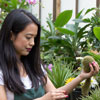When I first planted my Black Madeira fig tree in the corner of my San Diego property, I had no idea this unassuming specimen would become one of my most treasured cultivars. Known scientifically as Ficus carica ‘Black Madeira’, this Portuguese beauty goes by several names depending on where you’re standing on the globe.
Some folks call it the San Pedro Black, others know it as Figo Preto, and in certain Mediterranean circles, you’ll hear it referred to simply as Madeira. But regardless of what you call it, this fig variety has earned its place as a cornerstone of my exotic fruit collection.
Let me take you on a journey through my experience with this remarkable tree, sharing the lessons I’ve learned, the challenges I’ve overcome, and why I believe every serious fruit grower in Southern California should consider adding this variety to their orchard.
Why the Black Madeira Captured My Heart
You know that feeling when you bite into a fruit and time seems to stop for just a moment? That’s exactly what happened the first time I tasted a perfectly ripe Black Madeira fig. The deep purple-black skin gave way to a jammy, amber-red interior that tasted like honey mixed with berry compote and a hint of earthiness. It wasn’t just sweet—it was complex, sophisticated, the kind of flavor that makes you close your eyes and savor every second.
Here in San Diego, we’re blessed with what I call “fig paradise” conditions. Our Mediterranean climate, with its mild winters and warm, dry summers, mimics the Black Madeira’s native Portuguese habitat almost perfectly. The tree thrives in USDA zones 7-10, and San Diego sits comfortably in zone 10a, which means we rarely see the freezing temperatures that can damage these beauties.
What sets the Black Madeira apart from other fig varieties in my orchard—and trust me, I’ve tried dozens—is its remarkable adaptability and generous production. While some figs are temperamental divas, requiring constant attention and specific conditions, the Black Madeira is more like that reliable friend who always shows up and delivers. It produces two crops annually: a smaller breba crop in early summer from the previous year’s wood, and a larger main crop in late summer to fall.
Growing Secrets I’ve Discovered Through Trial and Error
Let me share something most agricultural guides won’t tell you: figs are forgiving, but they reward those who pay attention to details. When I planted my first Black Madeira sapling, I made almost every rookie mistake in the book. I overwatered it, planted it in the shadiest part of my property (thinking I was protecting it from San Diego’s intense summer sun), and pruned it at completely the wrong time. That poor tree looked at me like I was trying to torture it.
But here’s the beautiful thing about Ficus carica—it’s resilient. After relocating it to a sunnier spot with better drainage and adjusting my care routine, the tree bounced back and has been thriving ever since. Now, I’ve got the formula down to a science, and my Black Madeira consistently produces over 100 pounds of fruit each season.
Essential Growing Conditions for Success:
- Full sun exposure (minimum 6-8 hours daily, though mine gets about 10)
- Well-draining soil with pH between 6.0-6.5
- Deep watering once weekly during growing season, less in winter
- Organic mulch layer to retain moisture and regulate soil temperature
- Protection from strong winds that can damage the large, distinctive leaves
- Annual pruning in late winter to maintain shape and encourage production
The soil composition makes a tremendous difference. I’ve enriched my planting area with compost and aged manure, creating a nutrient-rich environment that doesn’t retain excessive moisture. Figs hate wet feet—root rot is one of the few things that can seriously threaten these otherwise tough trees.
The Production Calendar: What to Expect Month by Month
Understanding the Black Madeira’s growth cycle transformed my harvesting strategy and helped me maximize yield. Let me break down what happens in my orchard throughout the year:
Monthly Growth and Harvest Timeline:
- January-February: Dormant period; this is when I do my main pruning, removing dead wood and shaping the canopy
- March-April: Leaf emergence and explosive spring growth; breba figs begin developing on last year’s wood
- May-June: First harvest of breba crop; these early figs are larger but less sweet than the main crop
- July: Tree focuses energy on new wood growth and developing the main crop
- August-September: Peak harvest season; figs ripen in waves, and I’m out there almost daily
- October: Final fruits ripen; I usually get stragglers well into early November thanks to San Diego’s extended growing season
- November-December: Tree begins entering dormancy; leaves drop as temperatures cool
This predictable pattern allows me to plan my harvest and coordinate with the local restaurants and farmers’ markets where I sell my premium figs. The Black Madeira’s extended harvest window is a significant advantage—while some varieties give you a two-week bonanza followed by nothing, this cultivar keeps producing for months.
From Tree to Table: Maximizing Your Harvest
Have you ever noticed how a perfectly ripe fig at the market costs as much as a fancy coffee? There’s a reason for that. Figs are incredibly delicate and have a shelf life measured in days, not weeks. This is precisely why growing your own Black Madeira makes such practical and economic sense.

I’ve learned to be vigilant during peak season because the wildlife loves these figs as much as I do. Birds, particularly mockingbirds and finches, have impeccable timing and will strip a tree bare if you’re not careful. I’ve installed bird netting on one side of my tree and embraced a philosophy of sharing on the other—the birds get their portion, and I get mine. It’s a compromise that works surprisingly well.
| Comparison of Black Madeira vs. Common Fig Varieties |
|---|
| Characteristic |
| Fruit Size |
| Skin Color |
| Flesh Color |
| Sugar Content |
| Cold Tolerance |
| Breba Crop |
| Main Crop |
The sugar content in Black Madeira figs is particularly noteworthy. Using my refractometer, I consistently measure Brix levels between 18-22%, which is exceptionally high. This natural sweetness means the figs are perfect for eating fresh, and they also dry beautifully without requiring any additional sweeteners.
Creative Uses Beyond Fresh Eating
While I could happily eat Black Madeira figs straight off the tree every single day during harvest season, I’ve discovered dozens of ways to preserve and showcase this fruit. My wife started making fig jam after our first abundant harvest, and now it’s become something of a signature product at our farmers’ market stand. The deep, complex flavor of the Black Madeira creates a preserve that’s far superior to anything you’ll find in stores.
I’ve also experimented with drying these figs, which concentrates their sweetness and creates a chewy, candy-like treat that stores for months. The process is simple: I split them in half, place them on drying racks in my greenhouse, and let the San Diego sun do its magic over 3-4 days. Some folks use dehydrators, but I prefer the traditional method—there’s something satisfying about using the same sun that grew the fruit to preserve it.
One of my restaurant clients, a chef at a farm-to-table establishment in La Jolla, incorporates my Black Madeira figs into his seasonal menu in ways I never imagined. He makes a fig gastrique that accompanies duck breast, wraps them with prosciutto and goat cheese for appetizers, and even features them in a dessert pizza with mascarpone and honey. Watching a professional chef work with your produce is humbling and exciting—it validates all the early mornings and careful cultivation.
The Economics of Growing Black Madeira Figs
Let’s talk numbers, because at the end of the day, even those of us who love farming need to make it financially viable. A mature Black Madeira tree in optimal conditions can produce 100-150 pounds of fruit annually. In San Diego, premium fresh figs retail for anywhere from $8-12 per pound at farmers’ markets. Even if I’m wholesaling to restaurants at a lower price point (typically $4-6 per pound), the math works beautifully.
Consider this breakdown for a single mature tree:
| Economic Analysis: Black Madeira Fig Production |
|---|
| Category |
| Average Annual Yield |
| Wholesale Price per Pound |
| Gross Revenue |
| Annual Maintenance Costs (water, fertilizer, labor) |
| Net Profit per Tree |
| Break-even Point (from initial sapling) |
| Tree Productive Lifespan |
These figures don’t even account for the value-added products like jams, dried figs, or the personal enjoyment of having unlimited fresh figs throughout the season. When you factor in that a mature tree requires only a few hours of attention per year (pruning, occasional pest monitoring, harvest), the return on investment is exceptional.
Challenges and How I’ve Overcome Them
I’d be dishonest if I painted growing Black Madeira figs as completely problem-free. Like any agricultural endeavor, there are challenges. The most significant issue I’ve faced is the dreaded fig mosaic virus, which manifested as yellowing and distorted leaves on one of my younger trees. There’s no cure for this viral infection, so prevention through careful sanitation of pruning tools and purchasing certified disease-free stock is essential.

The intense summer heat, while generally beneficial for fruit ripening, can occasionally cause sunburn on exposed figs. I’ve learned to maintain enough canopy density to shade developing fruit while still ensuring adequate air circulation to prevent fungal issues. It’s a delicate balance, like so many things in farming.
Why You Should Plant Your Own Black Madeira
So here’s my pitch to you: if you live anywhere with a Mediterranean climate, reasonable winter temperatures, and enough space for a medium-sized tree (they typically reach 10-15 feet tall and wide, though size can be managed through pruning), you owe it to yourself to plant a Black Madeira fig.
This isn’t just about the fruit, though that alone would justify the space. It’s about connecting with a plant that has fed humans for thousands of years, about the satisfaction of harvesting something incredibly delicious that you grew with your own hands, and about the simple pleasure of walking outside on an August morning to pick a sun-warmed fig for breakfast.
The Black Madeira has taught me patience—that first harvest from a young tree seems to take forever. It’s taught me observation—learning to read the subtle signs that tell you when conditions are optimal or when something needs attention. And it’s taught me generosity—there’s something inherently shareable about a fig harvest, a natural abundance that invites you to give to neighbors, friends, and even the occasional bird.
In my orchard, surrounded by dragon fruit cacti, passion fruit vines, and cherimoya trees, the Black Madeira fig holds a special place. It’s not the flashiest or most exotic, but it’s reliable, generous, and consistently delicious. Like that friend I mentioned earlier—the one who always shows up—it’s become indispensable.
Whether you’re an experienced fruit grower looking to diversify or a beginner drawn to the romantic idea of plucking fresh figs from your own tree, the Black Madeira won’t disappoint. Just remember: full sun, well-draining soil, patience during establishment, and appreciation for one of nature’s most perfect fruits. Everything else is just details.
And trust me, when you taste your first home-grown Black Madeira fig, picked at the peak of ripeness on a warm San Diego afternoon, you’ll understand why I’ve dedicated so much of my orchard to this Portuguese treasure. Some fruits are worth the wait, worth the effort, worth the space. Ficus carica ‘Black Madeira’ is unquestionably one of them.








